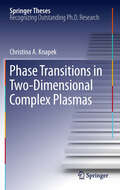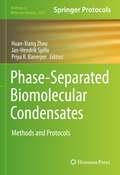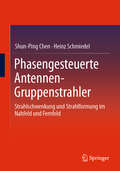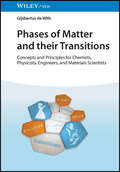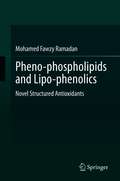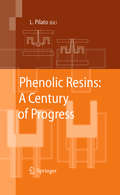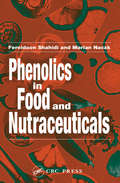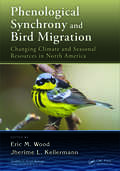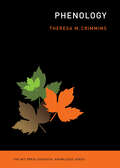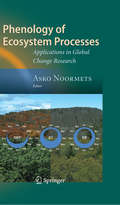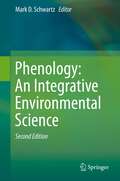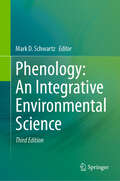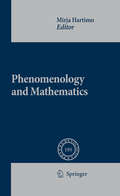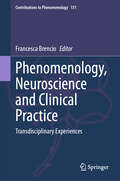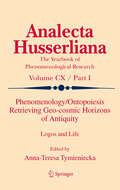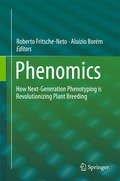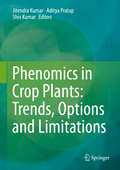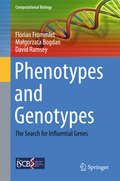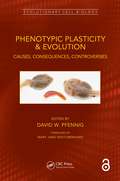- Table View
- List View
Phase Transitions in Two-Dimensional Complex Plasmas
by Christina A. KnapekThe two experimental studies reported in this thesis contribute important new knowledge about phase transitions in two-dimensional complex plasmas: in one case a determination of the coupling parameter (ratio of mean potential to mean kinetic energy of the particles in an ensemble), and in the other a detailed characterization of the non-equilibrium recrystallization of a two-dimensional system. The latter results are used to establish the connection between structural order parameters and the kinetic energy, which in turn gives novel insights into the underlying physical processes determining the two-dimensional phase transition.
Phase-Separated Biomolecular Condensates: Methods and Protocols (Methods in Molecular Biology #2563)
by Huan-Xiang Zhou Jan-Hendrik Spille Priya R. BanerjeeThis volume provides readers with a broad collection of theoretical, computational, and experimental methods to quantitatively study the properties of phase-separate biomolecular condensates in diverse systems. The chapters in this book cover topics such as theoretical and computational methods; methods for in vitro characterization of biomolecular condensates; and techniques that enable in-cell characterization of biomolecular condensates. Written in the highly successful Methods in Molecular Biology series format, chapters include introduction to their respective topics, lists of the necessary materials and reagents, step-by-step, readily reproducible laboratory protocols, and expert tips on troubleshooting and avoiding known pitfalls.Comprehensive and thorough, Phase-Separated Biomolecular Condensates: Methods and Protocols is a valuable resource that helps researchers learn and use established methods to study both biophysical properties and biological functions of biomolecular condensates.
Phased Arrays for Radio Astronomy, Remote Sensing, and Satellite Communications (EuMA High Frequency Technologies Series)
by Karl F. Warnick Rob Maaskant Marianna V. Ivashina David B. Davidson Brian D. JeffsDiscover a modern approach to the analysis, modeling and design of high sensitivity phased arrays. Network theory, numerical methods and computational electromagnetic simulation techniques are uniquely combined to enable full system analysis and design optimization. Beamforming and array signal processing theory are integrated into the treatment from the start. Digital signal processing methods such as polyphase filtering and RFI mitigation are described, along with technologies for real-time hardware implementation. Key concepts from interferometric imaging used in radio telescopes are also considered. A basic development of theory and modeling techniques is accompanied by problem sets that guide readers in developing modeling codes that retain the simplicity of the classical array factor method while incorporating mutual coupling effects and interactions between elements. Combining current research trends with pedagogical material suitable for a first-year graduate course, this is an invaluable resource for students, teachers, researchers, and practicing RF/microwave and antenna design engineers.
Phasengesteuerte Antennen- Gruppenstrahler: Strahlschwenkung und Strahlformung im Nahfeld und Fernfeld
by Shun-Ping Chen Heinz SchmiedelIn diesem Buch werden die Grundlagen der Strahlformung von Antennen erläutert. Die Prinzipien der Strahlfokussierung und Strahlschwenkung im Nah- und Fernfeld werden mit 2D- und 3D-Simulationen visualisiert und mit Messergebnissen verglichen. Neben linearen und planaren Antennen-Gruppenstrahlern werden auch konforme Gruppenstrahler, also konkave und konvexe Antennen-Gruppenstrahler, die für bestimmte Anwendungen geeignet sind, untersucht und vorgestellt. Auch verwandte Anwendungen der Strahlformung, wie Open-Loop- und Closed-Loop-Antennen-Gruppenstrahler oder Massive MIMO, eine der bahnbrechenden Technologien für 5G und zukünftiges 6G, die eine extrem große Anzahl von Antennenelementen für die Multi-Nutzer-Funkversorgung erfordert, werden behandelt. Weiterhin wird auch Strahlformung der sogenannten ausgedünnten Antennen-Gruppenstrahler mit großen Abständen zwischen den Antennenelementen diskutiert. Dieses Buch richtet sich sowohl an Forschungs- und Entwicklungsingenieure als auch an Studierende in den Bereichen Hochfrequenztechnik und Telekommunikation.
Phases of Matter and their Transitions: Concepts and Principles for Chemists, Physicists, Engineers, and Materials Scientists
by Gijsbertus de WithPhases of Matter and their Transitions An all-in-one, comprehensive take on matter and its phase properties In Phases of Matter and their Transitions, accomplished materials scientist Dr. Gijsbertus de With delivers an accessible textbook for advanced students in the molecular sciences. It offers a balanced and self-contained treatment of the thermodynamic and structural aspects of phases and the transitions between them, covering solids, liquids, gases, and their interfaces. The book lays the groundwork to describe particles and their interactions from the perspective of classical and quantum mechanics and compares phenomenological and statistical thermodynamics. It also examines materials with special properties, like glasses, liquid crystals, and ferroelectrics. The author has included an extensive appendix with a guide to the mathematics and theoretical models employed in this resource. Readers will also find: Thorough introductions to classical and quantum mechanics, intermolecular interactions, and continuum mechanics Comprehensive explorations of thermodynamics, gases, liquids, and solids Practical discussions of surfaces, including their general aspects for solids and liquids Fulsome treatments of discontinuous and continuous transitions, including discussions of irreversibility and the return to equilibrium Perfect for advanced students in chemistry and physics, Phases of Matter and their Transitions will also earn a place in the libraries of students of materials science.
Pheno-phospholipids and Lipo-phenolics: Novel Structured Antioxidants
by Mohamed Fawzy RamadanNatural phenolics are powerful bioactive compounds, but their use as antioxidant agents in lipid-based foodstuffs and cosmetics is limited due to their hydrophilic traits. A promising technique to overcome low solubility of phenolics is to increase their hydrophobicity by grafting with lipophilic moiety to form lipid-enriched phenolics (lipo-phenolics). Another way to enhance the amphiphilic traits of phenolics is by lipophilization with phospholipids in a suitable solvent to form phenolics-enriched phospholipids (pheno-phospholipids). Both functionalized phenolics (phenolipids) exhibit high bioavailability and antioxidative potential. Functional phenolics-enriched phospholipids (pheno-phospholipids) play an important role in enhancing the functional properties of both phenolic compounds and phospholipids in food for their use in nutrition and health. Phenolipids have also found applications on an industrial scale, likely due to low costs, the availability of starting material and safety. Recent advances in the field of lipophilization allow accessing molecules with high potency and targeted action covering a wide spectrum of bioactivities. Owing to their cost and availability, phenolipids find applications in niche sectors such as cosmetics and pharmaceutics as well as in the novel food. This book reports on the chemistry, preparation, and functionality of lipid-enriched phenolics (lipo-phenolics), broadening their applications in food, pharmaceuticals and cosmetics. The strategies of the lipophilization of phenolics, the effect of modification on the biological properties and potential applications of the resulting lipo-phenolics are reviewed. The text also discusses the preparation, physicochemical characteristics and functional properties of phenolipids and phytosomes, including the latest developments and their current industrial status.
Phenolic Antioxidants in Foods: Chemistry, Biochemistry and Analysis
by Alam ZebPlant foods are an essential part of our daily diet and constitute one of the highest contributors to the world economy. These foods are rich in phenolic compounds, which play a significant role in maintaining our health. This textbook presents a comprehensive overview of the chemistry, biochemistry and analysis of phenolic compounds present in a variety of foods. The text can be used as a singular source of knowledge for plant food science and technology, covering all of the important chemical, biochemical and analytical aspects needed for a thorough understanding of phenolic antioxidants in foods.Phenolic Antioxidants In Foods: Chemistry, Biochemistry, and Analysis is comprised of three sections. The first section covers the basic concepts of antioxidants, their chemistry and their chemical composition in foods, providing a detailed introduction to the concept. The second section covers the biochemical aspects of phenolic antioxidants, including their biosynthetic pathways, biological effects and the molecular mechanism of antioxidant effects in the biological system. This section promotes an understanding of the fundamental biochemical reactions that take place in foods and after digestion and absorption. The third section covers the analytical chemistry used in the analysis of phenolic antioxidants in foods, including the basic analytical procedures, methods for analysis and chromatographic and spectroscopic analyses. This section is significant for aspiring food chemists and manufacturers to evaluate the nature and chemistry of phenolic antioxidants in foods. Featuring helpful quizzes, section summaries, and key chapter points, this textbook is the perfect learning tool for advanced chemistry undergraduates and post-graduates looking to gain a fundamental understanding of phenolic antioxidants in food products.
Phenolic Based Foams: Preparation, Characterization, and Applications (Gels Horizons: From Science to Smart Materials)
by Sabu Thomas Sandhya P. K. SreekalaThis book covers the latest developments in phenolic foams and their applications. Compared with polystyrene and polyurethane foams, phenolic foams are known as third-generation polymeric foams. Phenolic foams exhibit excellent fire-retardant properties, including low flammability, low peak heat release rate, no dripping during combustion, and low toxicity. This book discusses various aspects of phenolic foams including properties, synthesis, fabrication methodologies, and applications. The contents also cover the methods for toughening of phenolic foams to make them more widely applicable. This book is of interest to both academics and industry alike. It is also a useful reference for fire safety regulators and policy-makers looking for new materials and methods for sustainable fire protection.
Phenolic Resins: A Century of Progress
by Louis PilatoWith global capacity in excess of 5 million tons annually, phenolic resins are one of the leading thermosetting resins that are used in many diverse industries such as wood adhesives, fiberglass/mineral wool binder, molded materials for autos/electronic/electrical industries, brakes, abrasives, foam, coatings/adhesives, laminates, composites, metal castings/refractories, and rubber industry. These phenolic resin business areas are critical to the national economy and general welfare of emerging and developed nations. Although phenolic resins are barely noticed in these applications, it is difficult to imagine their absence since they are vital and not easily replaced by other polymeric materials due to favorable cost/performance characteristics of phenolic resins. In this new book these application areas are summarized and updated by global phenolic experts that are engaged daily in these activities. Further new technology and application areas of global technical activity are presented and include nanotechnology, updated phenolic resin chemistry, carbon fiber and long glass fiber reinforced molding materials, new analyses/testing, carbon foam, carbon/carbon brakes for autos, photo resists, new fiber reinforced systems, renewable raw materials, and recycling. It is anticipated that the new book will feature a global perspective of phenolic resins through the participation of international (North America, Europe and Asia) phenolic experts that was lacking in all previous books related to phenolic resins.
Phenolics in Food and Nutraceuticals
by Fereidoon Shahidi Marian NaczkPhenolics in Food and Nutraceuticals is the first single-source compendium of essential information concerning food phenolics. This unique book reports the classification and nomenclature of phenolics, their occurrence in food and nutraceuticals, chemistry and applications, and nutritional and health effects. In addition, it describes antioxidant a
Phenological Research
by Irene L. Hudson Marie R. KeatleyAs climate change continues to dominate the international environmental agenda, phenology - the study of the timing of recurring biological events - has received increasing research attention, leading to an emerging consensus that phenology can be viewed as an 'early warning system' for climate change impact. A multidisciplinary science involving many branches of ecology, geography and remote sensing, phenology to date has lacked a coherent methodological text. This new synthesis, including contributions from many of the world's leading phenologists, therefore fills a critical gap in the current biological literature. Providing critiques of current methods, as well as detailing novel and emerging methodologies, the book, with its extensive suite of references, provides readers with an understanding of both the theoretical basis and the potential applications required to adopt and adapt new analytical and design methods. An invaluable source book for researchers and students in ecology and climate change science, the book also provides a useful reference for practitioners in a range of sectors, including human health, fisheries, forestry, agriculture and natural resource management.
Phenological Synchrony and Bird Migration: Changing Climate and Seasonal Resources in North America (Studies in Avian Biology)
by Eric M. Wood Jherime L. KellermannBird migration is a well-researched phenological event. However, few studies in North America have investigated the effects of climate change and extreme weather on the relationships of migratory avian species and their seasonal resources. This is a critical gap in knowledge that limits our ability to prioritize management and conservation applicat
Phenology (The MIT Press Essential Knowledge series)
by Theresa M. CrimminsOn the timing of seasonal activity in plants and animals, the impact of climate change, and what each of us, as everyday phenologists, can do to help.Phenology is all about timing—when trees leaf out, flowers bloom, birds migrate, animals bear young and hibernate—and it is everywhere around us. This handy companionable volume shows how we are all phenologists in our own way, and how the everyday science can help us make sense of the changing seasons and our changing world. Explaining how the phenomenon of phenology is threaded through our daily lives, Theresa Crimmins points to events that occur on an annual basis in plants’ and animals’ lives in response to fluctuations in daylength, temperatures, and rainfall patterns. She also covers less visible seasonal events, such as when roots typically begin to grow or when mushrooms release their spores. On a more urgent note, Phenology describes how this seasonal activity is being affected by rapidly changing climate conditions—and why this matters. Consequently, the book invites readers to participate in documenting the timing of seasonal life cycle events—for the practice’s real benefits to mental health, but also for the good of the environment, as the data gathered can be directly helpful in supporting climate change action.
Phenology of Ecosystem Processes
by Asko NoormetsTerrestrial carbon balance is uncertain at the regional and global scale. A significant source of variability in mid-latitude ecosystems is related to the timing and duration of phenological phases. Spring phenology, in particular, has disproportionate effects on the annual carbon balance. However, the traditional phenological indices that are based on leaf-out and flowering times of select indicator species are not universally amenable for predicting the temporal dynamics of ecosystem carbon and water exchange. Phenology of Ecosystem Processes evaluates current applications of traditional phenology in carbon and H2O cycle research, as well as the potential to identify phenological signals in ecosystem processes themselves. The book summarizes recent progress in the understanding of the seasonal dynamics of ecosystem carbon and H2O fluxes, the novel use of various methods (stable isotopes, time-series, forward and inverse modeling), and the implications for remote sensing and global carbon cycle modeling. Each chapter includes a literature review, in order to present the state-of-the-science in the field and enhance the book's usability as an educational aid, as well as a case study to exemplify the use and applicability of various methods. Chapters that apply a specific methodology summarize the successes and challenges of particular methods for quantifying the seasonal changes in ecosystem carbon, water and energy fluxes. The book will benefit global change researchers, modelers, and advanced students.
Phenology: An Integrative Environmental Science
by Mark D. SchwartzPhenology refers to recurring plant and animal life cycle stages, such as leafing and flowering, maturation of agricultural plants, emergence of insects, and migration of birds. It is also the study of these recurring events, especially their timing and relationships with weather and climate. Phenological phenomena all give a ready measure of the environment as viewed by the associated organism, and are thus ideal indicators of the impact of local and global changes in weather and climate on the earth's biosphere. Assessing our changing world is a complex task that requires close cooperation from experts in biology, climatology, ecology, geography, oceanography, remote sensing, and other areas. Like its predecessor, this second edition of Phenology is a synthesis of current phenological knowledge, designed as a primer on the field for global change and general scientists, students, and interested members of the public. With updated and new contributions from over fifty phenological experts, covering data collection, current research, methods, and applications, it demonstrates the accomplishments, progress over the last decade, and future potential of phenology as an integrative environmental science.
Phenology: An Integrative Environmental Science
by Mark D. SchwartzPhenology refers to recurring plant and animal life cycle stages, such as leafing and flowering, maturation of agricultural plants, emergence of insects, and migration of birds. It is also the study of these recurring events, especially their timing and relationships with weather and climate. Phenological phenomena all give a ready measure of the environment as viewed by the associated organism and are thus ideal indicators of the impact of local and global changes in weather and climate on the earth’s biosphere. Assessing our changing world is a complex task that requires close cooperation from experts in biology, climatology, ecology, geography, oceanography, remote sensing, and other areas. Like its two predecessors, this third edition of Phenology is a synthesis of current phenological knowledge, designed as a primer on the field for global change and general scientists, students, and interested members of the public. With updated and new contributions from over sixty phenological experts, covering data collection, current research, methods, and applications, it demonstrates the accomplishments, progress over the last decade, and future potential of phenology as an integrative environmental science.
Phenomenological Approaches to Physics (Synthese Library #429)
by Harald A. Wiltsche Philipp BerghoferThis book offers fresh perspective on the role of phenomenology in the philosophy of physics which opens new avenues for discussion among physicists, "standard" philosophers of physics and philosophers with phenomenological leanings.Much has been written on the interrelations between philosophy and physics in the late 19th and early 20th century, and on the emergence of philosophy of science as an autonomous philosophical sub-discipline. This book is about the under-explored role of phenomenology in the development and the philosophical interpretation of 20th century physics. Part 1 examines questions about the origins and value of phenomenological approaches to physics. Does the work of classical phenomenologists such as Husserl, Merleau-Ponty or Heidegger contain elements of systematic value to both the practice and our philosophical understanding of physics? How did classical phenomenology influence “standard” philosophy of science in the Anglo-American and other traditions? Part 2 probes questions on the role of phenomenology in the philosophies of physics and science:- Can phenomenology help to solve “Wigner’s puzzle”, the problem of the "unreasonable effectiveness" of mathematics in describing, explaining and predicting empirical phenomena? - Does phenomenology allow better understanding of the principle of gauge invariance at the core of the standard model of contemporary particle physics? - Does the phenomenological notion of “Lifeworld” stand in opposition to the “scientific metaphysics” movement, or is there potential for dialogue? Part 3 examines the measurement problem. Is the solution outlined by Fritz London and Edmond Bauer merely a re-statement of von Neumann’s view, or should it be regarded as a distinctively phenomenological take on the measurement problem? Is phenomenology a serious contender in continuing discussions of foundational questions of quantum mechanics? Can other interpretational frameworks such as quantum Bayesianism benefit from implementing phenomenological notions such as constitution or horizonal intentionality?
Phenomenology and Mathematics
by Mirja HartimoDuring Edmund Husserl's lifetime, modern logic and mathematics rapidly developed toward their current outlook and Husserl's writings can be fruitfully compared and contrasted with both 19th century figures (Boole, Schröder, Weierstrass) as well as the 20th century characters (Heyting, Zermelo, Gödel). Besides the more historical studies, the internal ones on Husserl alone and the external ones attempting to clarify his role in the more general context of the developing mathematics and logic, Husserl's phenomenology offers also a systematically rich but little researched area of investigation. This volume aims to establish the starting point for the development, evaluation and appraisal of the phenomenology of mathematics. It gathers the contributions of the main scholars of this emerging field into one publication for the first time. Combining both historical and systematic studies from various angles, the volume charts answers to the question "What kind of philosophy of mathematics is phenomenology?"
Phenomenology and QBism: New Approaches to Quantum Mechanics (Routledge Studies in the Philosophy of Mathematics and Physics)
by Harald A. Wiltsche Philipp BerghoferThis volume brings together philosophers and physicists to explore the parallels between Quantum Bayesianism, or QBism, and the phenomenological tradition. It is the first book exclusively devoted to phenomenology and quantum mechanics. By emphasizing the role of the subject’s experiences and expectations, and by explicitly rejecting the idea that the notion of physical reality could ever be reduced to a purely third-personal perspective, QBism exhibits several interesting parallels with phenomenology. The central message of QBism is that quantum probabilities must be interpreted as the experiencing agent’s personal Bayesian degrees of belief—degrees of belief for the consequences of their actions on a quantum system. The chapters in this volume elaborate whether and specify how phenomenology could serve as the philosophical foundation of QBism. This objective is pursued from the perspective of QBists engaging with phenomenology as well as the perspective of phenomenologists engaging with QBism. These approaches enable us to realize a better understanding of quantum mechanics and the world we live in, achieve a better understanding of QBsim, and introduce the phenomenological foundations of quantum mechanics. Phenomenology and QBism is an essential resource for researchers and graduate students working in philosophy of physics, philosophy of science, quantum mechanics, and phenomenology.
Phenomenology, Neuroscience and Clinical Practice: Transdisciplinary Experiences (Contributions to Phenomenology #131)
by Francesca BrencioThis book offers fundamental insights into three main fields of education and expertise: phenomenology, neuroscience, and clinical practice. The richness and pluralism of the contributions aim to overcome the reductionist and dualistic approach to mental health and shed new light on clinical practice. Designed as both an education tool for mental health professionals, and a theoretical investigation for philosophers on the use of phenomenology in clinical practice, this book highlights the need for a new direction on mental health, and more general, on human wellbeing. This volume aims to fill the gap between philosophers and mental health professionals on an educational level, in a space unique in its open and transdisciplinary approach. It appeals to students and researchers but also very much to professionals and clinicians in the field.
Phenomenology/Ontopoiesis Retrieving Geo-cosmic Horizons of Antiquity
by Anna-Teresa TymienieckaThe controversy of flux and stasis as the groundwork of reality of Greek ancient philosophy reached its crux in the all encompassing doctrine of the logos by Heraclitus of Ephesus. It centers upon human soul in its role with the cosmos. Philosophy of the Occident corroborating Greek insights with the progress of culture in numerous interpretations (Kant, Kierkegaard, Husserl, Merleau-Ponty, Ricoeur...), presented in this collection has neglected the cosmic sphere. While contemporary development of science revealed its grounding principles (papers by Grandpierre, Kule and Trutty-Coohill) the ancient logos fully emerges. Thus, logos hitherto hidden in our commerce with earth is revealed in its intertwinings with the cosmos through the trajectories of the phenomenology/ontopoiesis of life (Tymieniecka). The crucial link between the soul and the cosmos, in a new geo-cosmic horizon, is thus being retrieved.
Phenomics
by Roberto Fritsche-Neto Aluízio BorémThis book represents a pioneer initiative to describe the new technologies available for next-generation phenotyping and applied to plant breeding. Over the last several years plant breeding has experienced a true revolution. Phenomics, i. e. , high-throughput phenotyping using automation, robotics and remote data collection, is changing the way cultivars are developed. Written in an easy to understand style, this book offers an indispensable reference work for all students, instructors and scientists who are interested in the latest innovative technologies applied to plant breeding.
Phenomics in Crop Plants: Trends, Options and Limitations
by Aditya Pratap Jitendra Kumar Shiv KumarIdentification of desirable genotypes with traits of interest is discernible for making genetic improvement of crop plants. In this direction, screening of a large number of germplasm for desirable traits and transfer of identified traits into agronomic backgrounds through recombination breeding is the common breeding approach. Although visual screening is easier for qualitative traits, its use is not much effective for quantitative traits and also for those, which are difficult to score visually. Therefore, it is imperative to phenotype the germplasm accessions and breeding materials precisely using high throughput phenomics tools for challenging and complex traits under natural, controlled and harsh environmental conditions. Realizing the importance of phenotyping data towards identification and utilization of a germplasm as donors, global scientific community has exerted increased focus on advancing phenomics in crop plants leading to development of a number of techniques and methodologies for screening of agronomic, physiological, and biochemical traits. These technologies have now become much advanced and entered the era of digital science. This book provides exhaustive information on various aspects related to phenotyping of crop plants and offers a most comprehensive reference on the developments made in traditional and high throughput phenotyping of agricultural crops.
Phenotypes and Genotypes
by Florian Frommlet Małgorzata Bogdan David RamseyThistimely text presents a comprehensive guide to genetic association, a new andrapidly expanding field that aims to elucidate how our genetic code (genotypes)influences the traits we possess (phenotypes). The book provides a detailedreview of methods of gene mapping used in association with experimentalcrosses, as well as genome-wide association studies. Emphasis is placed onmodel selection procedures for analyzing data from large-scale genome scansbased on specifically designed modifications of the Bayesian informationcriterion. Features: presents a thorough introduction to the theoreticalbackground to studies of genetic association (both genetic and statistical); reviewsthe latest advances in the field; illustrates the properties of methods formapping quantitative trait loci using computer simulations and the analysis ofreal data; discusses open challenges; includes an extensive statisticalappendix as a reference for those who are not totally familiar with thefundamentals of statistics.
Phenotypic Plasticity & Evolution: Causes, Consequences, Controversies (Evolutionary Cell Biology)
by David W. PfennigPhenotypic plasticity – the ability of an individual organism to alter its features in direct response to a change in its environment – is ubiquitous. Understanding how and why this phenomenon exists is crucial because it unites all levels of biological inquiry. This book brings together researchers who approach plasticity from diverse perspectives to explore new ideas and recent findings about the causes and consequences of plasticity. Contributors also discuss such controversial topics as how plasticity shapes ecological and evolutionary processes; whether specific plastic responses can be passed to offspring; and whether plasticity has left an important imprint on the history of life. Importantly, each chapter highlights key questions for future research. Drawing on numerous studies of plasticity in natural populations of plants and animals, this book aims to foster greater appreciation for this important, but frequently misunderstood phenomenon. Key Features Written in an accessible style with numerous illustrations, including many in color Reviews the history of the study of plasticity, including Darwin’s views Most chapters conclude with recommendations for future research
